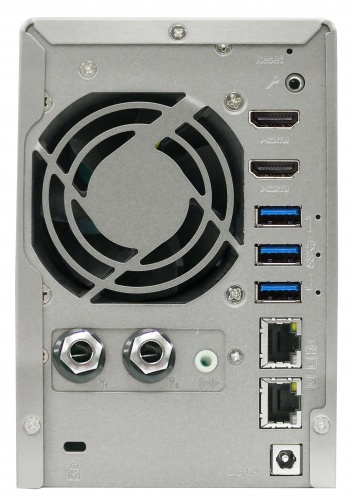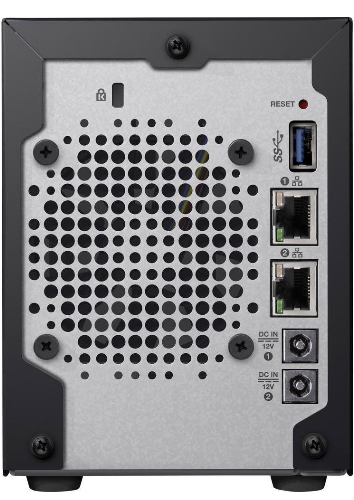NAS for Plex, as well as downloading from BitTorrent and subtitles, I’m now using an iMac but I will not have it in the near future. I really like the wd my cloud pr2100 but I don’t like its software and the fact that it hasn’t USB ports or HDMI. I really love the Qnap 253A, I find it very beautiful and the software and hardware are perfect! Also, I will have a projector (and get rid of my tv) so I need it to play directly to the projector (for example HBO), actually I use for this a fire tv stick.
I have to be honest and say, it is very difficult to compete with Qnap. It comes with not only one HMDI port but two. Also instead of one USB port at the back, it has three. It even has audio in/out for karaoke or simple audio output. Both NAS have quite powerful processors with transcoding engines built in for resizing 4K media on the fly. HDMI port will let you directly connect NAS to a TV or projector with no risk of network bandwidth limitations. That will let you enjoy a smooth stream of video with no interruptions. And you still have another HDMI port to use for surveillance camera management or turning NAS into a PC.
Both NAS options have dual LAN ports for making connection double as fast or twice as reliable. WD NAS features dual power supply which makes it very business-like solution. For environments with many users where NAS uptime is very important. Both models have also a one-touch backup button for automatic data transfer from/to external drive.
Remote on Qnap NAS is the thing which takes WD out as an option for your home multimedia solution. WD does not offer that, but it will be very useful for controlling your Plex app or other apps on your screen. So decision, in this case, is very clear- TS-253A
| Intel® Celeron® N3150/N3160 1.6 GHz quad-core processor
cpubenchmark.net 1700 Intel HD Graphics Transcoding 2 x Gigabit RJ-45 Ethernet port 2 x HDMI, up to 4K 2160P 30Hz Ultra HD support USB one-touch-backup button Remote support Noise: 18.3 dB(A)
|
Intel Pentium N3710 1.6 GHz (Burst speed up to 2.56 GHz)
cpubenchmark.net 1870 Intel HD Graphics Transcoding 2 x Gigabit RJ-45 Ethernet port -NO HDMI USB one-touch-backup button NO Remote Noise: not mentioned dual power supply
|
* Sound Level Test Environment:
Refer to ISO 7779 ; Maximum HDD loaded ; Bystander Position; Average data from 1 meter in front of operating NAS.


What can I connect to a NAS?
Wireless Speaker Sonos
The great thing about Sonos is that you don’t need to pay for music subscription service. With the cheapest NAS at home like DS218j or any other, you can have your backups done for all of your devices and still use your network drive as a Sonos music library. Sonos will connect to your NAS via your network and let access your provided music library. If you have little more of IT knowledge, you can even set up your Alexa or Sonos with Alexa built in to play music on your voice commands (“Alexa! Ask DS Audio to Play Music!”).
Casting devices
Nowadays it is so cheap to upgrade your old TV and make it smart. All you need is Google Chrome or EZcast alternative plugged into your HDMI port at the back of your TV. Now you have great functionality added to your TV to send a video file directly from your NAS to a TV. No need for wires and chargers and other mess. You can use your phone as a remote to go to your movies or family videos and cast that content on your TV during family or friend gatherings.
Amazon Fire TV
You may not have a smartphone, or you just simply prefer to control your content with a remote in that case Amazon Fire TV will be a great addon to get to your TV. It also plugs into your HDMI port and will play content from your NAS to a TV. No wires no mess.
nVidia Shield TV
It gets even better! If you want some more entertainment and all previously mentioned functions – nVidia TV is a great thing to get. You can use it for playing games and watching movies from your NAS. The greatest thing is – shield TV does video transcoding. So even if you have a cheap NAS with a weak CPU, in a combination of shield TV you can now automatically on the fly change video file size and format for a destination device. It is a great way to reduce network load and let older devices to play video content which normally was not supported on the device.
Find regulary updated NAS offers here
Of course I would prefer you choose AMAZON UK AMAZON USA to buy your perfect solution, however, if you would rather buy locally, please use the links used above to take you to your local Amazon store and help support this free advice service with ad revenue. More ways of supporting the blog are described HERE
Home: https://www.backblaze.com/cloud-backup.html#af9rgr Business: https://www.backblaze.com/business-backup.html#af9rgr Comparison with other service providers: https://www.backblaze.com/best-online-backup-service.html#af9rgr
| Where to Buy a Product | |||
|
|
    
|

|
VISIT RETAILER ➤ |
 |
    
|

|
VISIT RETAILER ➤ |
 |
    
|

|
VISIT RETAILER ➤ |
 |
    
|

|
VISIT RETAILER ➤ |
We use affiliate links on the blog allowing NAScompares information and advice service to be free of charge to you. Anything you purchase on the day you click on our links will generate a small commission which is used to run the website. Here is a link for Amazon and B&H. You can also get me a ☕ Ko-fi or old school Paypal. Thanks! To find out more about how to support this advice service check HERE
Minisforum MS-02 Ultra - WHO IS THIS FOR??? (The First 48HRs)
Why People Use TrueNAS, UnRAID and Proxmox to Turnkey NAS (Synology, QNAP, etc)
Why People Prefer Turnkey NAS vs TrueNAS, UnRAID and More
The Top 5 Mistakes NAS Buyers Make
Top 5 PLEX/Jellyfin NAS of 2025
Seagate Ironwolf vs WD Red NAS Hard Drives
Access content via Patreon or KO-FI
Discover more from NAS Compares
Subscribe to get the latest posts sent to your email.





DISCUSS with others your opinion about this subject.
ASK questions to NAS community
SHARE more details what you have found on this subject
IMPROVE this niche ecosystem, let us know what to change/fix on this site